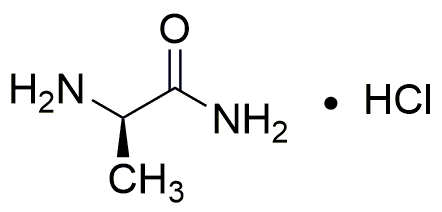D-Alanine amide hydrochloride is widely utilized in research focused on:
- Peptide Synthesis: This compound serves as a building block in the synthesis of peptides, which are essential in drug development and biochemistry.
- Neuroscience Research: It is used in studies related to neurotransmitter function, helping researchers understand brain signaling pathways and potential treatments for neurological disorders.
- Pharmaceutical Formulations: D-Alanine amide hydrochloride is incorporated into various pharmaceutical products, enhancing their efficacy and stability.
- Biochemical Assays: The compound is employed in assays to measure enzyme activity, providing insights into metabolic processes and disease mechanisms.
- Food Industry Applications: It is explored as a flavor enhancer and preservative, contributing to improved taste and shelf-life of food products.
General Information
Properties
Safety and Regulations
Applications
D-Alanine amide hydrochloride is widely utilized in research focused on:
- Peptide Synthesis: This compound serves as a building block in the synthesis of peptides, which are essential in drug development and biochemistry.
- Neuroscience Research: It is used in studies related to neurotransmitter function, helping researchers understand brain signaling pathways and potential treatments for neurological disorders.
- Pharmaceutical Formulations: D-Alanine amide hydrochloride is incorporated into various pharmaceutical products, enhancing their efficacy and stability.
- Biochemical Assays: The compound is employed in assays to measure enzyme activity, providing insights into metabolic processes and disease mechanisms.
- Food Industry Applications: It is explored as a flavor enhancer and preservative, contributing to improved taste and shelf-life of food products.
Documents
Safety Data Sheets (SDS)
The SDS provides comprehensive safety information on handling, storage, and disposal of the product.
Product Specification (PS)
The PS provides a comprehensive breakdown of the product’s properties, including chemical composition, physical state, purity, and storage requirements. It also details acceptable quality ranges and the product's intended applications.
Certificates of Analysis (COA)
Search for Certificates of Analysis (COA) by entering the products Lot Number. Lot and Batch Numbers can be found on a product’s label following the words ‘Lot’ or ‘Batch’.
*Catalog Number
*Lot Number
Certificates Of Origin (COO)
This COO confirms the country where the product was manufactured, and also details the materials and components used in it and whether it is derived from natural, synthetic, or other specific sources. This certificate may be required for customs, trade, and regulatory compliance.
*Catalog Number
*Lot Number
Safety Data Sheets (SDS)
The SDS provides comprehensive safety information on handling, storage, and disposal of the product.
DownloadProduct Specification (PS)
The PS provides a comprehensive breakdown of the product’s properties, including chemical composition, physical state, purity, and storage requirements. It also details acceptable quality ranges and the product's intended applications.
DownloadCertificates of Analysis (COA)
Search for Certificates of Analysis (COA) by entering the products Lot Number. Lot and Batch Numbers can be found on a product’s label following the words ‘Lot’ or ‘Batch’.
*Catalog Number
*Lot Number
Certificates Of Origin (COO)
This COO confirms the country where the product was manufactured, and also details the materials and components used in it and whether it is derived from natural, synthetic, or other specific sources. This certificate may be required for customs, trade, and regulatory compliance.


